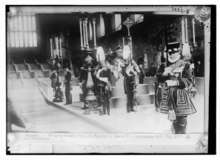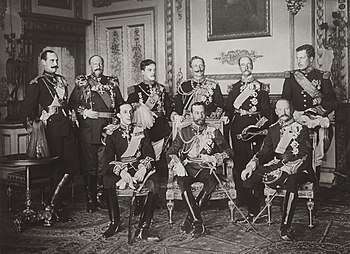Funeral of King Edward VII
The funeral of Edward VII, king of the United Kingdom of Great Britain and Ireland and emperor of India, occurred on Friday, 20 May 1910.
The funeral procession of King Edward VII, passing through Windsor. | |
| Date | Friday, 20 May 1910 |
|---|---|
| Location | Westminster Abbey, London (official ceremony) St George's Chapel, Windsor Castle (resting place) |
| Participants | British Royal Family |
The funeral was the largest gathering of European royalty ever to take place, with representatives of 70 states, and the last before many royal families were deposed in the First World War and its aftermath.[1]
Organisation

King Edward VII had died on 6 May, and following a private lying in state in the Throne Room at Buckingham Palace,[2] on 17 May the coffin was taken in procession to Westminster Hall, where there was a public lying in state.[3] This was the first to be held in the hall for a member of the Royal Family and was inspired by the lying in state of William Gladstone there in 1898.[2] On the first day, thousands of members of the public queued patiently in the rain to pay their respects; some 25,000 people were turned away when the gates were closed at 10 pm. On 19 May, Kaiser Wilhelm II wanted to have the hall closed while he laid a wreath; however, the police advised that there might be disorder if that happened, so the Kaiser was taken in through another entrance while the public continued to file past.[4] An estimated half a million people visited the hall during the three days that it was open.[5]
The funeral was held two weeks after the king's death on 20 May. Huge crowds gathered to watch the procession, which passed from Buckingham Palace to Westminster Hall, where a small ceremony was conducted by the archbishop of Canterbury, Randall Davidson, before a small group of official mourners – the late King's widow Queen Alexandra, his son King George V, his daughter The Princess Victoria, his brother the Duke of Connaught, and his nephew the German Emperor. The remainder of the funeral party waited outside the Hall, consisting of thousands of people. Big Ben, the bell in the nearby clock tower, was rung 68 times, one for each year of Edward VII's life. This was the first time it was used in this way at a monarch's funeral.[6]
The whole procession then proceeded from Westminster Hall, via Whitehall and the Mall, from Hyde Park Corner up to the Marble Arch, and thence to Paddington Station. From there, a train conveyed the mourners to Windsor. The procession then continued on to Windsor Castle, and a full funeral ceremony was held in St George's Chapel.
The funeral directors to the Royal Household appointed to assist during this occasion were the family business of William Banting of St James's Street, London. The Banting family also conducted the funerals of King George III in 1820, King George IV in 1830, the Duke of Gloucester in 1834, the Duke of Wellington in 1852, Prince Albert in 1861, Prince Leopold in 1884, and Queen Victoria in 1901. The royal undertaking warrant for the Banting family ended in 1928 with the retirement of William Westport Banting.[7]
People in the procession

The funeral was notable for the enormous number of important European and world royalty who participated in it. The funeral procession saw a horseback procession, followed by 11 carriages.
Figures on horseback included the following, along with various military figures and equerries (given roughly in the order they rode:
.jpg)
- The King of the United Kingdom, the late King's son
- The German Emperor, King of Prussia, the late King's nephew
- The Duke of Connaught and Strathearn, the late King's brother
- The King of the Hellenes, the late King's brother-in-law
- The King of Spain, the late King's nephew-in-law
- The King of Norway, the late King's nephew and son-in-law
- The King of Denmark, the late King's brother-in-law
- The King of Portugal, a fellow member of the House of Saxe-Coburg and Gotha
- The Tsar of the Bulgarians, a fellow member of the House of Saxe-Coburg and Gotha
- The King of the Belgians, a fellow member of the House of Saxe-Coburg and Gotha
- The Archduke of Austria-Este, heir presumptive to the throne of Austria-Hungary (representing the Emperor of Austria)
- The Crown Prince of the Ottoman Empire (representing the Ottoman Sultan)
- Grand Duke Michael Alexandrovich of Russia, younger brother of the Russian Emperor; the late King's nephew
- The Duke of Aosta, cousin of the King of Italy
- Prince Fushimi Sadanaru, cousin of the Emperor of Japan
- The Crown Prince of Greece, the late King's nephew
- The Crown Prince of Romania, the late King's nephew-in-law (representing the King of Romania)
- Prince Rupprecht of Bavaria, grandson of the Prince-Regent of Bavaria
- Duke Albrecht of Württemberg, cousin of the King of Württemberg[8]
- The Crown Prince of Serbia (representing the King of Serbia)
- Prince Henry of the Netherlands, husband of the Queen of the Netherlands
- The Grand Duke of Hesse and by Rhine, the late King's nephew
- The Grand Duke of Mecklenburg-Strelitz
- Prince Henry of Prussia, the late King's nephew
- The Duke of Saxe-Coburg and Gotha, the late King's nephew
- Prince Johann Georg of Saxony, brother of the King of Saxony
- The Duke of Västergötland, brother of the King of Sweden and the late King's nephew-in-law
- The Prince of Waldeck and Pyrmont
- Prince Mohammed Ali of Egypt, heir presumptive to the throne of Egypt (representing the Khedive of Egypt and Sudan)
- Prince Arthur of Connaught, the late King's nephew
- Prince Christian of Schleswig-Holstein, the late King's brother-in-law
- Prince Albert of Schleswig-Holstein, the late King's nephew
- Prince Alexander of Battenberg, the late King's nephew
- The Duke of Fife, the late King's son-in-law
- The Duke of Teck, brother-in-law of the late King's successor
- Prince Francis of Teck, brother-in-law of the late King's successor
- Prince Alexander of Teck, brother-in-law of the late King's successor and the late king's nephew-in-law
- Prince Andrew of Greece and Denmark, the late King's nephew
- Grand Duke Michael Mikhailovich of Russia
- Prince Maximilian of Baden, the late King's nephew-in-law, heir presumptive to the throne of Baden (representing the Grand Duke of Baden)
- The Crown Prince of Montenegro (representing the Prince of Montenegro)
- Prince Christopher of Greece and Denmark, the late King's nephew
- Prince Philipp of Saxe-Coburg and Gotha
- The Hereditary Grand Duke of Mecklenburg-Strelitz
- Prince Luís of Orléans-Braganza
- The Duke of Penthièvre, a member of the French Orléanist royal house
- Prince August Leopold of Saxe-Coburg and Gotha
- Prince Wolrad of Waldeck-Pyrmont
- Prince Bovaradej of Siam, nephew of the King of Siam
Those who followed behind in the carriages included:
- Caesar, the late King's dog who led the funeral procession with a highlander walking behind the carriage that carried the King's coffin
- Queen Alexandra the Queen Mother, the late King's widow
- Dowager Empress Maria Feodorovna of Russia, the late King's sister-in-law
- The Princess Royal and Duchess of Fife, the late King's daughter
- The Princess Victoria, the late King's daughter
- The Queen of the United Kingdom, the late King's daughter-in-law
- The Queen of Norway, the late King's daughter
- The Duke of Cornwall, the late King's grandson
- The Princess Mary, the late King's granddaughter
- Princess Christian of Schleswig-Holstein, the late King's sister
- The Princess Louise, Duchess of Argyll, the late King's sister
- Princess Henry of Battenberg, the late King's sister
- The Duchess of Connaught and Strathearn, the late King's sister-in-law
- The Dowager Duchess of Albany, the late King's sister-in-law
- Princess Patricia of Connaught, the late King's niece
- Princess Alexandra of Fife, the late King's granddaughter
- Princess Maud of Fife, the late King's granddaughter
- Princess Helena Victoria of Schleswig-Holstein, the late King's niece
- Princess Marie Louise of Schleswig-Holstein, the late King's niece
- The Prince Albert, the late King's grandson
- The Prince Henry, the late King's grandson
- Prince George of Hanover and Cumberland, the late King's nephew
- Prince Zaitao of China, representing the Qing Dynasty, uncle to the Emperor
- Former President Theodore Roosevelt, representing the United States
- Foreign Affairs Minister Stephen Pichon, representing the French Republic
- Samad Khan Momtaz os-Saltaneh, representing Persia
Other relatives of the late king also attended the funeral:[9]
- Prince Louis of Battenberg, the late king's nephew-in-law
- The Duke of Argyll, the late king's brother-in-law
- Prince Maurice of Battenberg, the late king's nephew
- Count Edward Gleichen, the late king's half-first cousin once removed
- Prince George of Battenberg, the late king's grand-nephew
- The Duchess of Saxe-Coburg and Gotha, the late king's niece-in-law
- Princess Andrew of Greece and Denmark, the late king's grand-niece
- Princess Louis of Battenberg, the late king's niece
- The Duchess of Teck, sister-in-law of the late king's successor
- Princess Louise of Battenberg, the late king's grand-niece
- Princess Victor of Hohenlohe-Langenburg, widow of the late king's half-cousin
- Countess Feodora Gleichen, the late king's half-first cousin once removed
Notes
- Tuchman 2014, p. 1.
- Range, Matthias (2016). British Royal and State Funerals: Music and Ceremonial since Elizabeth I. Boydell Press. p. 277. ISBN 978-1783270927.
- "Plaque: Westminster Hall - Edward VII". www.londonremembers.com. London Remembers. Retrieved 23 November 2019.
- Hibbert, Christopher (2007). Edward VII: The Last Victorian King. Basingstoke, Hampshire: Palgrave Macmillan. p. 318. ISBN 978-1-4039-8377-0.
- Quigley, Christine (2005). The Corpse: A History. Jefferson NC: McFarland & Co. p. 67. ISBN 978-0786424498.
- Weinreb & Hibbert 1992, p. 66
- Todd Van Beck, "The Death and State Funeral of Sir Winston Leonard Spencer Churchill", part II, in Canadian Funeral News (October 2012), Vol. 40 Issue 10, p. 10 (online Archived 2014-03-16 at the Wayback Machine)
- Tuchman 2014, p. 6.
- "The London Gazette, Supplement:28401, Page:5471". www.thegazette.co.uk. TSO. 26 July 1910. Retrieved 24 November 2019.
References
Books
- Tuchman, Barbara W. (2014). Guns of August. Random House Trade. ISBN 978-0-345-38623-6.
- Weinreb, Ben; Hibbert, Christopher (1992). The London Encyclopaedia (reprint ed.). Macmillan.
News
- The Times, May 21, 1910
![]()